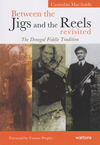
CAOIMHÍN MACAOIDH - Between The Jigs And The Reels Revisited: The Donegal Fiddle Tradition
Waltons Publishing ISBN: 9781857202243
Caoimhín MacAoidh is a familiar figure in Donegal fiddle circles, having spent a large chunk of his life studying, researching and playing fiddle music from the county, and helping to promote and preserve it through organisations such as Cairdeas na bhFidiléirí. In 1993 his book, Between The Jigs And The Reels, was published, giving great insight into the Donegal fiddle tradition, its history and its players, and now Waltons has issued this revised version, the enhancements in which bring the story right up to date.
The original book begins with a foreword from Tommy Peoples, one of the most well-known exponents of Donegal fiddling in recent years. He also wrote a foreword for this second edition, despite his failing health at the time, and sadly he passed away before he was able to finalise it. It is nevertheless printed here, as he left it, and is a poignant reminder of the part that he and many of the other fiddlers mentioned in the book’s pages have played in upholding the fiddle traditions of the area, and the role they played (and still play) in the passing on of the tunes, stories and traditions from one generation to another.
This first part of the book contains chapters detailing certain aspects of Donegal fiddle music: its history throughout the decades, including when the fiddle became common in Donegal, its links with Scotland, and where the music was mainly played; its influences from other instruments, particularly the pipes, and influences from wider Irish fiddle music, as well as Scottish music and classical music; its folklore, with lots of stories about enchanted fiddles and fiddlers, the faeries, ghosts and witches, and descriptions of tunes emanating from encounters with such beings. The opening chapters also deal with many of the different tune collections to feature Donegal fiddle music, with a nod to the ITMA and its important role as a repository for material relating to traditional music, and its ongoing interest in Donegal music. There’s also a chapter on dancing and its strong links with the music, going into detail about the dances that are found more commonly in Donegal than elsewhere (e.g., the Maggie Pickie, a solo step dance found in Donegal that has several local variations). I found these opening chapters of great interest, with lots of stories and examples to develop whatever knowledge I already had. I particularly enjoyed the places where the stories behind the tunes were recounted. I’ve heard them told often by many of the older generation of players, and their inclusion here is an important way of preserving them in the players’ own words.
Following this, the bulk of the book’s 400 pages consists of several chapters, each focussing on a geographical area of Donegal, where Caoimhín pays tribute to historical and contemporary players from that area – some well-known, others less so – often showing the connections between them (in places, it’s a fairly tight-knit community up here). There are players mentioned that would not have been featured in the original book – some because they weren’t born at the time - and it is a tribute to Caoimhín that, apart from a few omissions which are bound to happen with this kind of project, he has given space to all. He gives biographical information on the players, but it is no dry exercise; it remains an informative and interesting read throughout. There’s a valuable chapter on Donegal’s Travelling Fiddlers – the McConnells, the Dohertys, the O’Rourkes - their role in the distribution of the music between isolated communities in the area, and their influences on today’s players. And there are sections on fiddlers from Derry, Belfast, Dublin, Glasgow, Newcastle, Niedorp, the USA, Australia and elsewhere who play Donegal music.
Caoimhín doesn’t shy away from sharing controversial or strong opinions – he includes some cutting comments in the section on accompaniment about bodhrán players (“…normally a disruptive device…”) and guitarists (“…held in only slightly milder disregard than the bodhrán…”), and most box players don’t fare too well either. I’m not sure how helpful these comments are, and they perhaps portray an image of Donegal fiddlers that doesn’t reflect my experience amongst most of them. But whatever you might feel about some of these views, there is no doubt that when it comes to fiddle music in Donegal, the writer knows his stuff. Extensive research and years of work have gone into the making and reworking of this book, and it really is an invaluable resource for anyone with an interest in the music of the area. It’s well written, and well laid out with black and white photos of some of the musicians. I learned a lot, and I know I’ll be dipping in and out of this for years to come.
www.waltons.ie
Fiona Heywood
This review appeared in Issue 144 of The Living Tradition magazine
